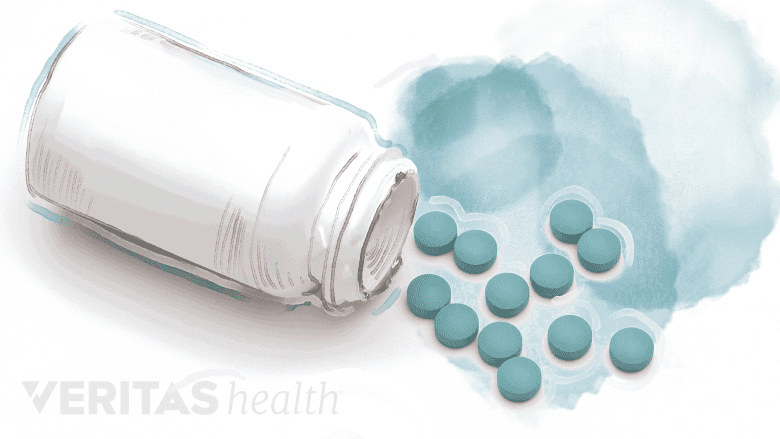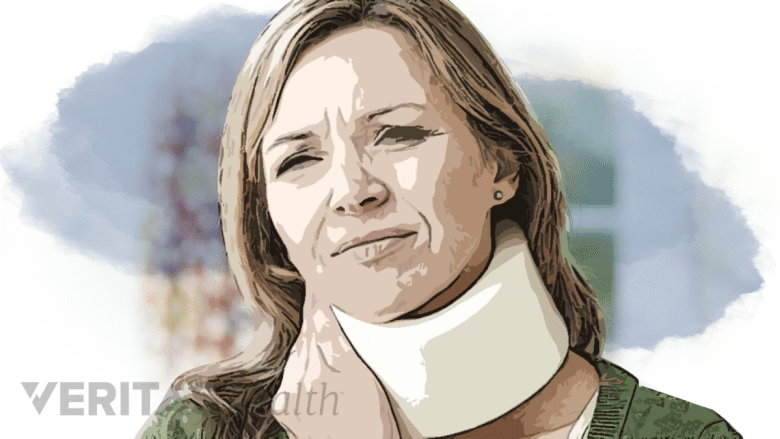The treatment of pain that stems from C1-C2 in the upper neck is usually nonsurgical. In rare cases when 3 months of treatments have not reduced the pain, or if a spinal instability threatens the spinal cord or a nerve root, surgery may be indicated.1Mead LB, Millhouse PW, Krystal J, Vaccaro AR. C1 fractures: a review of diagnoses, management options, and outcomes. Curr Rev Musculoskelet Med. 2016;9(3):255-62. Magnetic resonance imaging (MRI) or computed tomography (CT) scans are usually performed prior to any treatment to ensure spinal stability and normal vertebral artery flow.
Typically, recovery after nonsurgical treatment of C1-C2 takes 8 to 12 weeks.1Mead LB, Millhouse PW, Krystal J, Vaccaro AR. C1 fractures: a review of diagnoses, management options, and outcomes. Curr Rev Musculoskelet Med. 2016;9(3):255-62.,2Schleicher P, Scholz M, Pingel A, Kandziora F. Traumatic Spondylolisthesis of the Axis Vertebra in Adults. Global Spine J. 2015;5(4):346-58.
In This Article:
Nonsurgical Treatment for C1-C2
Some common nonsurgical treatments for C1-C2 include:
Medication

Prescription and over-the-counter (OTC) medication may help reduce neck pain.
Both over-the-counter (OTC) and prescription medications help relieve vertebral injury and nerve pain. Non-steroidal anti-inflammatory drugs (NSAIDs), tricyclic antidepressants, and muscle relaxants are examples of pain-relieving medications used for these injuries. Opioid pain medications may be prescribed for short durations in order to avoid the risk of addiction.
Immobilization

Immobilizing the neck prevents damage to injured vertebrae.
The use of a rigid neck collar or head and neck braces such as halo-thoracic brace or sterno-occipito-mandibular immobilization are used in fractures and/or dislocations of the C1-C2 vertebrae. This treatment method prevents movement of the neck in any direction, while also maintaining proper alignment of the head and neck, thereby reducing stresses on the injured vertebrae.1Mead LB, Millhouse PW, Krystal J, Vaccaro AR. C1 fractures: a review of diagnoses, management options, and outcomes. Curr Rev Musculoskelet Med. 2016;9(3):255-62.
Physical therapy
Physical therapy helps strengthen muscles around vertebrae and improves posture. Physical therapy of the C1-C2 vertebral level may help maintain head and neck balance, thereby preventing the risk of falls.3Kendler DL, Bauer DC, Davison KS, et al. Vertebral Fractures: Clinical Importance and Management. The American Journal of Medicine. 2016;129(2):221.e1-221.e10. doi:10.1016/j.amjmed.2015.09.020
See Physical Therapy for Neck Pain Relief
Chiropractic manipulation

A chiropractic adjustment may help relieve neck pain.
Manipulation of the cervical spine through chiropractic adjustment may help relieve pain stemming from C1-C2. This treatment, however, may not be recommended in cases where the stability of C1-C2 is compromised.
Traction
Traction refers to stretching and/or realigning the spine to relieve direct nerve pressure and stress on the vertebral levels. Traction of C1-C2 may help decrease compression of the C2 nerve. Traction of cervical vertebrae is a commonly recommended procedure for both adults and children. The results are often limited to short term pain relief. Traction can either be applied manually or by spinal traction devices.4Abi-Aad KR, Derian A. Cervical, Traction. StatPearls. Treasure Island (FL): StatPearls Publishing; 2018 Jan-. Available from: https://www.ncbi.nlm.nih.gov/books/NBK470412/
Injection

Steroid injections can be effective at treating C1-C2 pain.
Injection of anti-inflammatory or pain reducing medications such as corticosteroids in the epidural space or the atlantoaxial joint at C1-C2. These injections are usually performed under fluoroscopic (x-ray) guidance with radiopaque contrast dye. Studies have shown 80% of cases experiencing more than 50% reduction in C1-C2 pain after being treated with these injections.5Aiudi CM, Hooten WM, Sanders RA, et al. Outcomes of C1-2 joint injections. J Pain Res. 2017;10:2263-2269. Published 2017 Sep 18. doi:10.2147/JPR.S144255
Watch Cervical Epidural Steroid Injection Video
Several other nonsurgical treatments for upper neck pain may also be tried, such as acupuncture or transcutaneous electrical nerve stimulation (TENS).
Surgical Treatment for C1-C2

The C1 and C2 vertebrae may be fused together to give stability to the cervical spine.
Surgery of the C1-C2 vertebral and/or spinal level is usually considered in one or more of the following cases:
- When the transverse ligament—ligament that holds the C1 and C2 vertebrae together is partially or completely torn. This type of injury results in severe instability of the C1-C2 joint.1Mead LB, Millhouse PW, Krystal J, Vaccaro AR. C1 fractures: a review of diagnoses, management options, and outcomes. Curr Rev Musculoskelet Med. 2016;9(3):255-62.
- A piece of bone is detached and remains on the torn ligament, resulting in avulsion fracture.1Mead LB, Millhouse PW, Krystal J, Vaccaro AR. C1 fractures: a review of diagnoses, management options, and outcomes. Curr Rev Musculoskelet Med. 2016;9(3):255-62.
- A vertebral injury irritates or damages the C2 spinal nerve.1Mead LB, Millhouse PW, Krystal J, Vaccaro AR. C1 fractures: a review of diagnoses, management options, and outcomes. Curr Rev Musculoskelet Med. 2016;9(3):255-62.
- Stenosis or narrowing of the foramen of the C1-C2 vertebrae damages blood vessels and/or spinal nerves.6Nehete LS, Bhat DI, Gopalakrishnan MS, et al. Unusual cause of high cervical myelopathy-C1 arch stenosis. J Craniovertebr Junction Spine. 2018;9(1):37-43.
Surgical methods used in the C1-C2 vertebral levels include:
Fusion of the C1-C2 vertebrae. This surgery is usually performed at the back of the cervical spine. The fractured vertebrae are fixed together with wires, plates, and screws. This surgery provides a high level of stability to the damaged vertebrae. Pain relief from this procedure is usually seen in most cases, although some patients may experience low intensity, intermittent neck pain.7De Iure F, Donthineni R, Boriani S. Outcomes of C1 and C2 posterior screw fixation for upper cervical spine fusion. Eur Spine J. 2009;18 Suppl 1(Suppl 1):2-6.
Laminectomy or removal of the back or posterior portion of the C1 vertebral arch. This surgery helps relieve spinal cord compression in the C1 region due to excessive bone formation, resulting in stenosis of C1. The stability of C1 achieved from this technique is good, with reduction in pain and other symptoms in most cases.8Chang KC, Samartzis D, Fuego SM, et al. The effect of excision of the posterior arch of C1 on C1/C2 fusion using transarticular screws. Bone Joint J. 2013;95-B(7):972-6.
Watch: Cervical Laminectomy Video
- Odontoid screw fixation is done when the dens of C2 gets fractured. When the base of the dens is fractured, a screw facing upward is secured from dens to the C1 above to allow fusion of C1-C2.9Tenny S, Varacallo M. Odontoid Fractures (Dens Fractures) [Updated 2019 Jan 19]. In: StatPearls [Internet]. Treasure Island (FL): StatPearls Publishing; 2018 Jan-. Available from: https://www.ncbi.nlm.nih.gov/books/NBK441956/ The outcome is generally favorable, although a small risk of cerebrospinal fluid leakage persists with this surgery.10Wang L, Liu C, Zhao QH, Tian JW. Outcomes of surgery for unstable odontoid fractures combined with instability of adjacent segments. J Orthop Surg Res. 2014;9:64. Published 2014 Aug 28. doi:10.1186/s13018-014-0064-9
- Transoral odontoidectomy is the surgical removal of the dens. This procedure is performed when the dens is severely displaced and compresses the spinal cord. Typically, fusion of C1-C2 is done following this procedure.9Tenny S, Varacallo M. Odontoid Fractures (Dens Fractures) [Updated 2019 Jan 19]. In: StatPearls [Internet]. Treasure Island (FL): StatPearls Publishing; 2018 Jan-. Available from: https://www.ncbi.nlm.nih.gov/books/NBK441956/
In general, surgery to fuse C1-C2 results in a greater reduction in rotational range of motion for the head compared to other levels of the neck.
As with all surgeries, there is a small risk for serious complications, such as excessive bleeding, allergic reaction, infection, and others. Depending on the surgical procedure and the severity of the injury, recovery may take several months.
- 1 Mead LB, Millhouse PW, Krystal J, Vaccaro AR. C1 fractures: a review of diagnoses, management options, and outcomes. Curr Rev Musculoskelet Med. 2016;9(3):255-62.
- 2 Schleicher P, Scholz M, Pingel A, Kandziora F. Traumatic Spondylolisthesis of the Axis Vertebra in Adults. Global Spine J. 2015;5(4):346-58.
- 3 Kendler DL, Bauer DC, Davison KS, et al. Vertebral Fractures: Clinical Importance and Management. The American Journal of Medicine. 2016;129(2):221.e1-221.e10. doi:10.1016/j.amjmed.2015.09.020
- 4 Abi-Aad KR, Derian A. Cervical, Traction. StatPearls. Treasure Island (FL): StatPearls Publishing; 2018 Jan-. Available from: https://www.ncbi.nlm.nih.gov/books/NBK470412/
- 5 Aiudi CM, Hooten WM, Sanders RA, et al. Outcomes of C1-2 joint injections. J Pain Res. 2017;10:2263-2269. Published 2017 Sep 18. doi:10.2147/JPR.S144255
- 6 Nehete LS, Bhat DI, Gopalakrishnan MS, et al. Unusual cause of high cervical myelopathy-C1 arch stenosis. J Craniovertebr Junction Spine. 2018;9(1):37-43.
- 7 De Iure F, Donthineni R, Boriani S. Outcomes of C1 and C2 posterior screw fixation for upper cervical spine fusion. Eur Spine J. 2009;18 Suppl 1(Suppl 1):2-6.
- 8 Chang KC, Samartzis D, Fuego SM, et al. The effect of excision of the posterior arch of C1 on C1/C2 fusion using transarticular screws. Bone Joint J. 2013;95-B(7):972-6.
- 9 Tenny S, Varacallo M. Odontoid Fractures (Dens Fractures) [Updated 2019 Jan 19]. In: StatPearls [Internet]. Treasure Island (FL): StatPearls Publishing; 2018 Jan-. Available from: https://www.ncbi.nlm.nih.gov/books/NBK441956/
- 10 Wang L, Liu C, Zhao QH, Tian JW. Outcomes of surgery for unstable odontoid fractures combined with instability of adjacent segments. J Orthop Surg Res. 2014;9:64. Published 2014 Aug 28. doi:10.1186/s13018-014-0064-9

